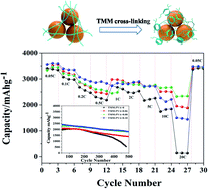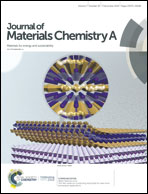A trimethylol melamine functionalized polyvinyl alcohol network for high performance nano-silicon anodes†
Abstract
Silicon materials are the most viable candidates to overcome the limitations of the capacity and energy density of conventional graphite. Nevertheless, this technology is still at an early stage and needs competitive strategies for the electrode fabrication. Herein, a functionalized 3-dimensional (3-D) polyvinyl alcohol (PVA) network is prepared via in situ cross-linking with a trimethylol melamine (TMM) bridge, which enables an electrode with much improved mechanics and ionic conductivity. Under optimized conditions, the nano-Si anode using the obtained 3-D PVA binder exhibits superior electrochemical properties with the first coulomb efficiency of 90.81% and a reversible capacity of more than 3000 mA h g−1. At 20 C (84 A g−1) current density, the Si anode is able to deliver a capacity of 2338 mA h g−1. After 500 electrochemical cycles, it can still retain more than 85% of the initial capacity. The underlying mechanisms for the electrochemical enhancement are discussed in terms of the electrode laminate mechanics and the improved ionic transportation due to the TMM incorporation. The simple and facile method by adopting a functional cross-linker shows great promise for use with Si anodes in lithium ion batteries.



 Please wait while we load your content...
Please wait while we load your content...